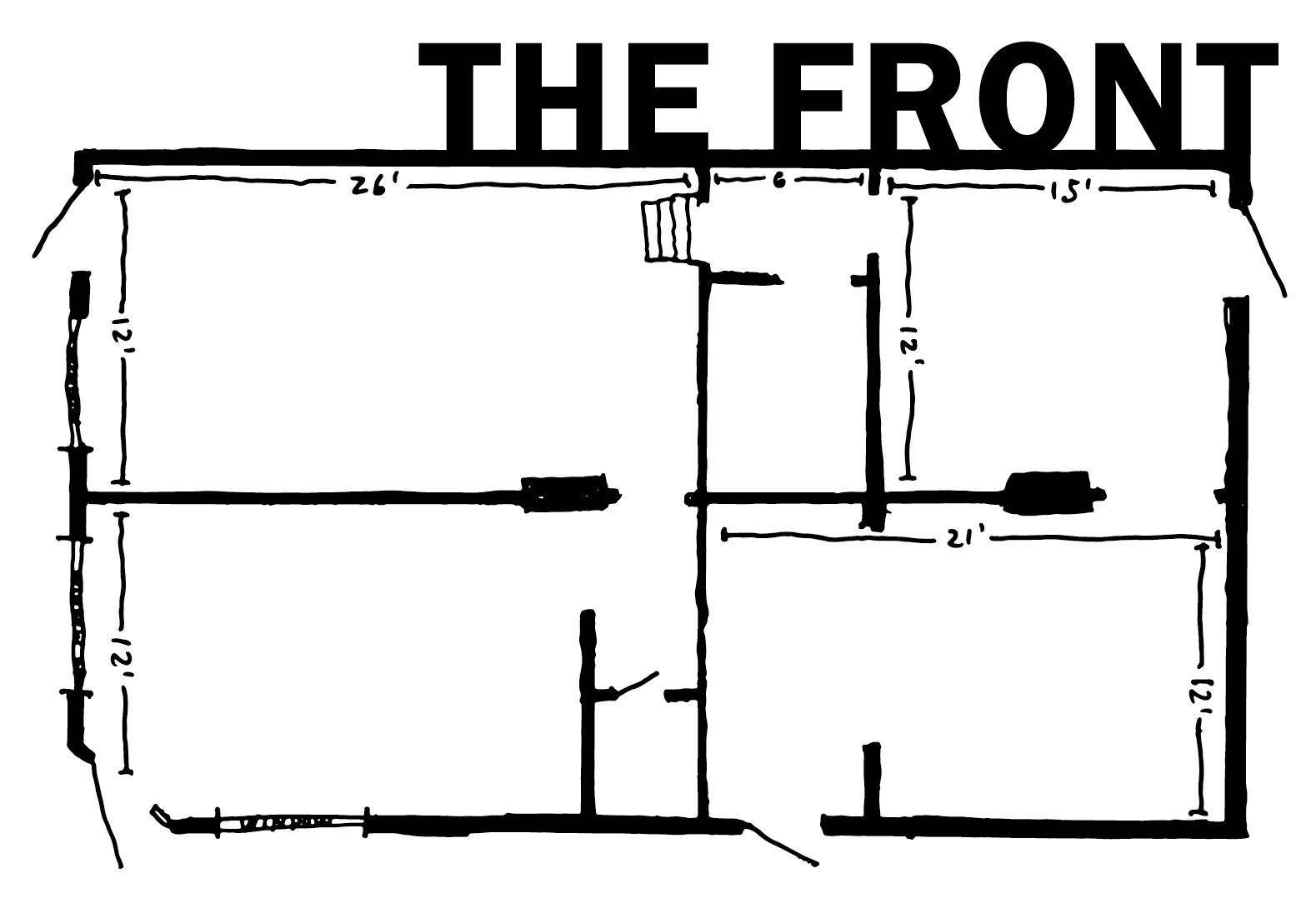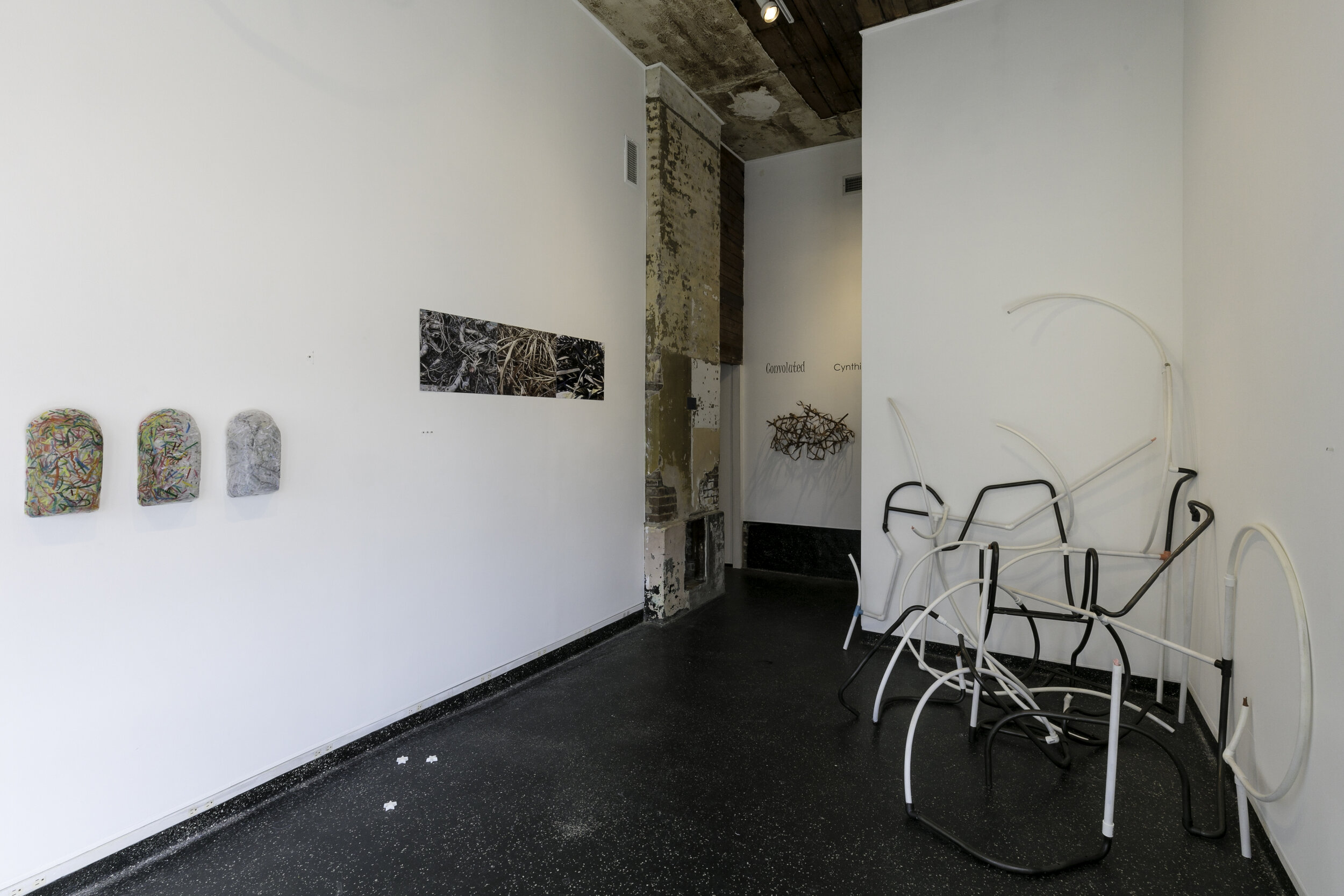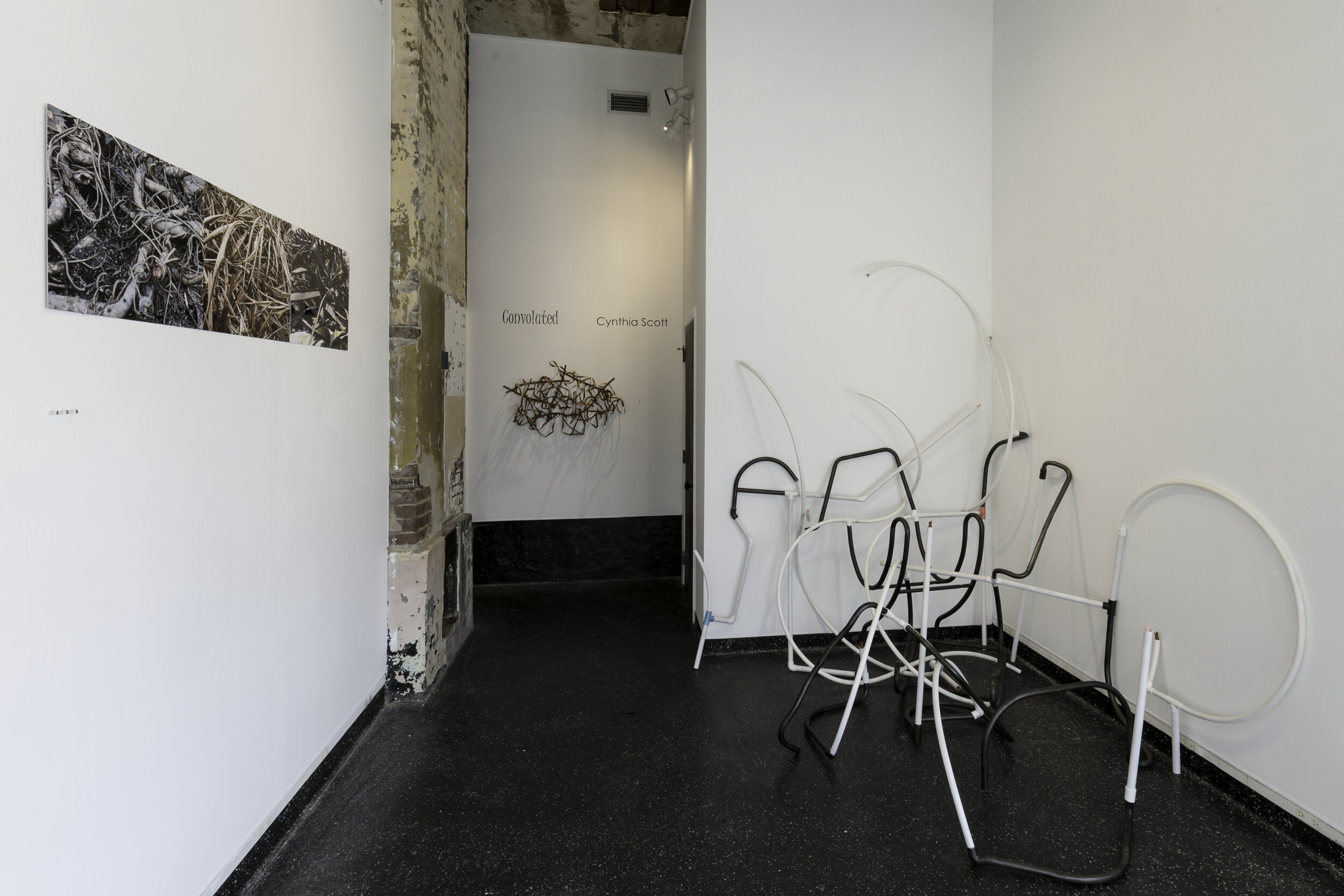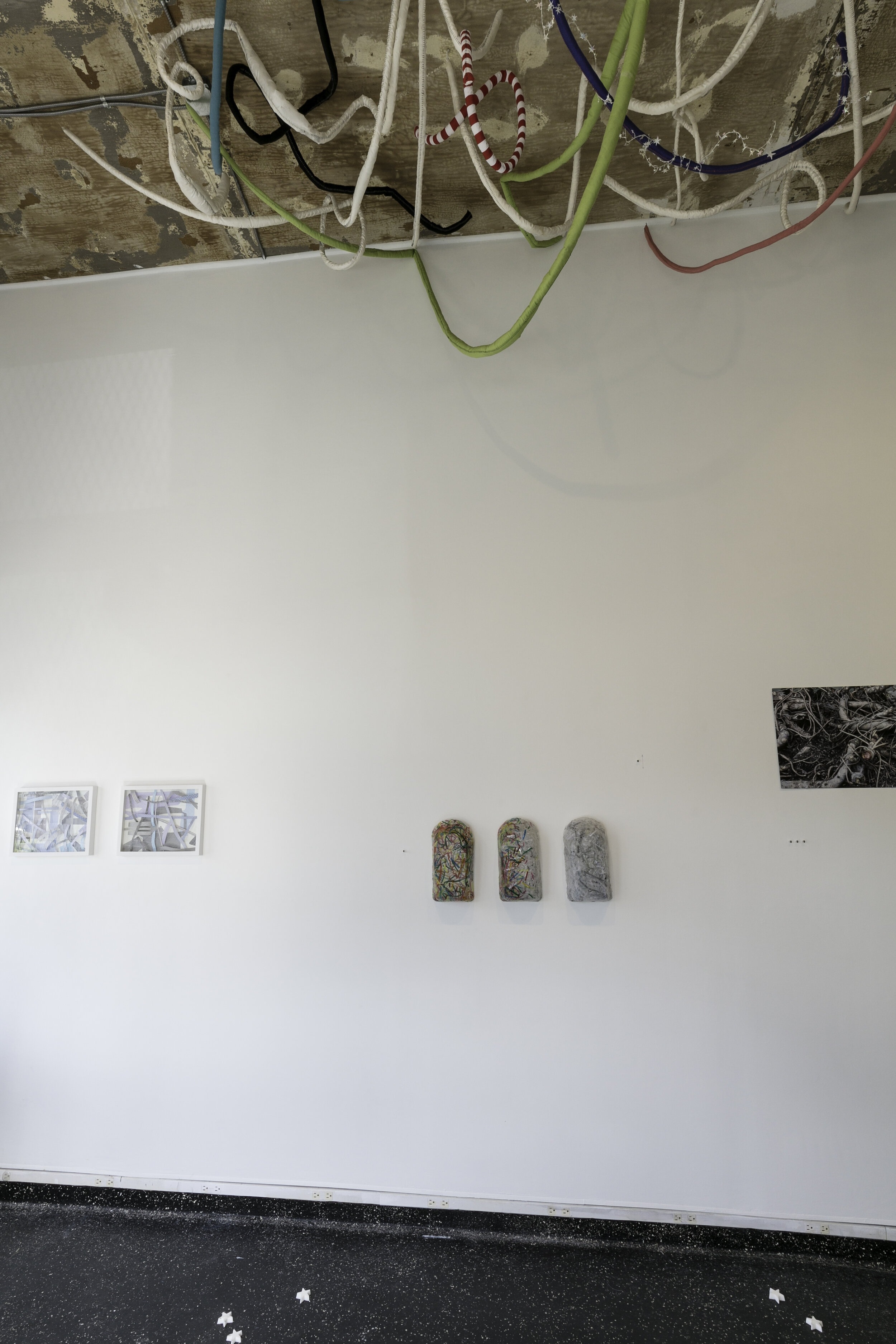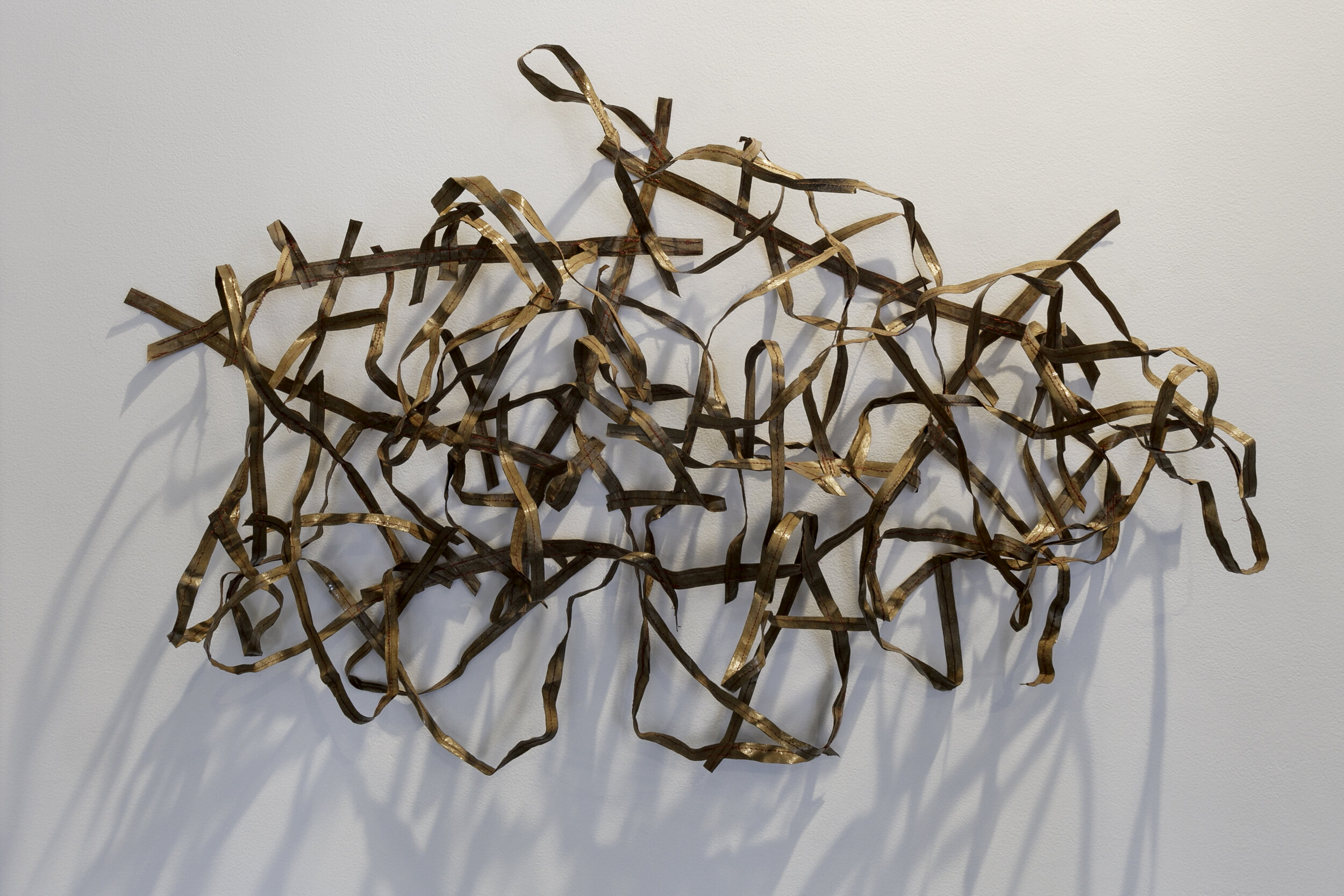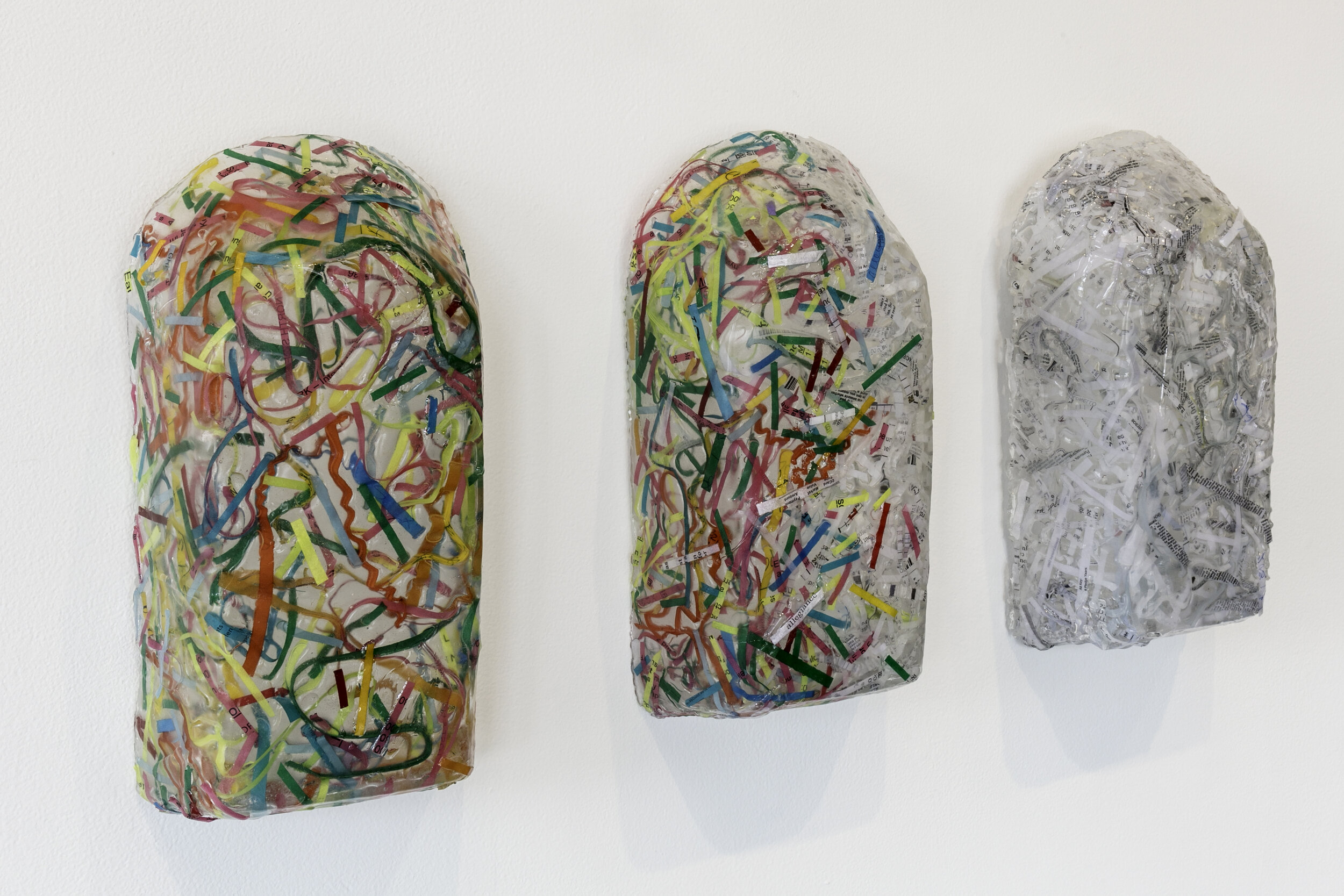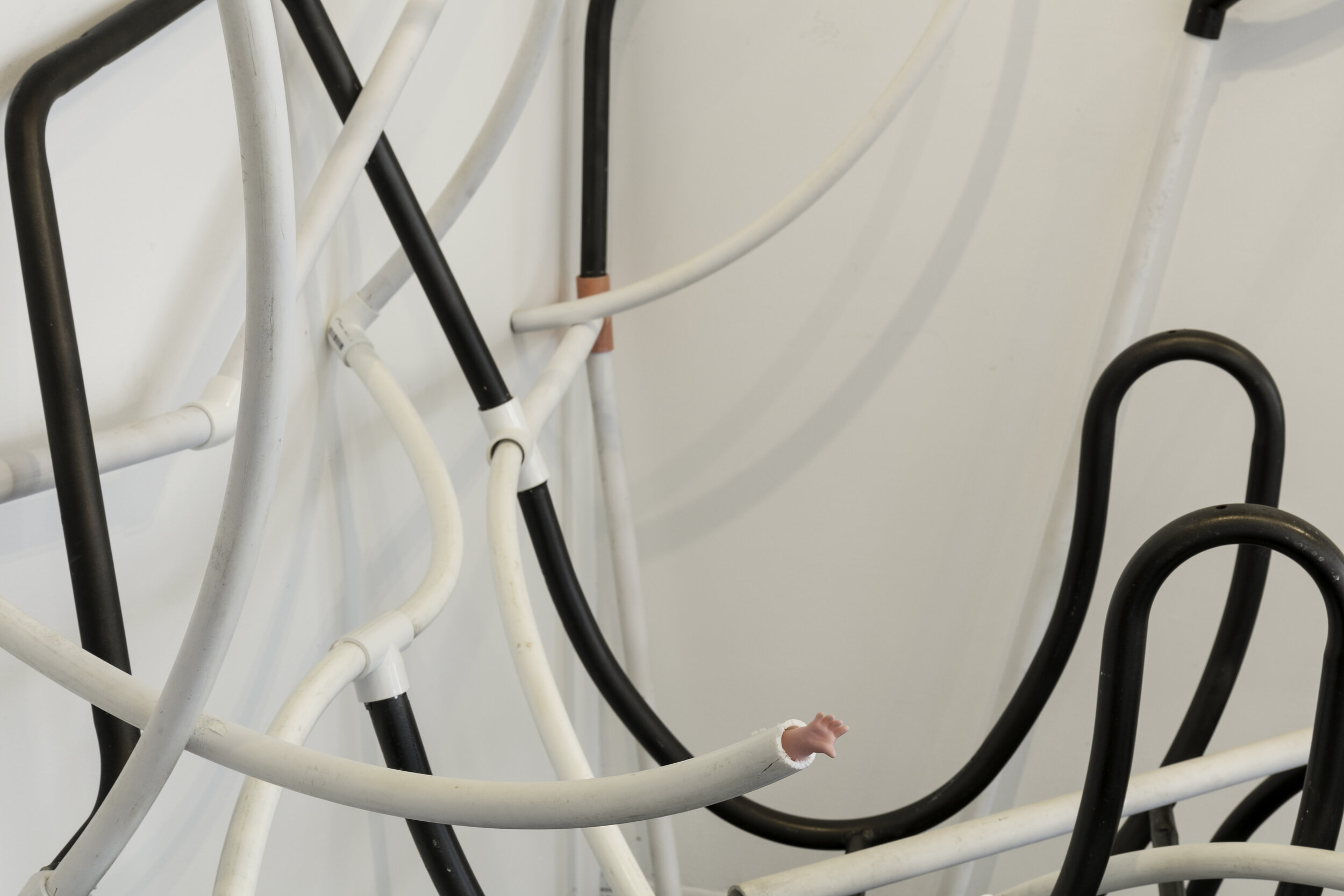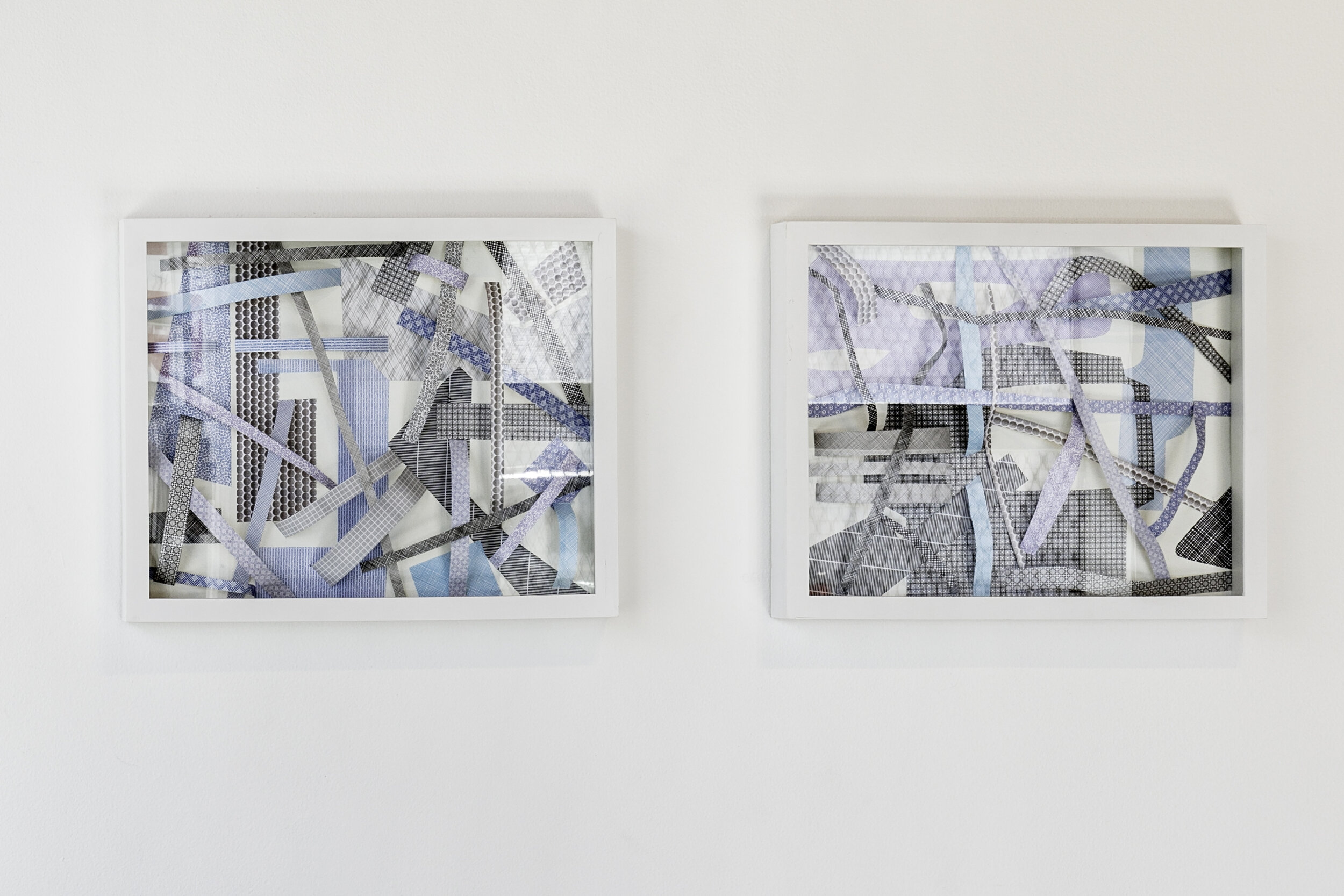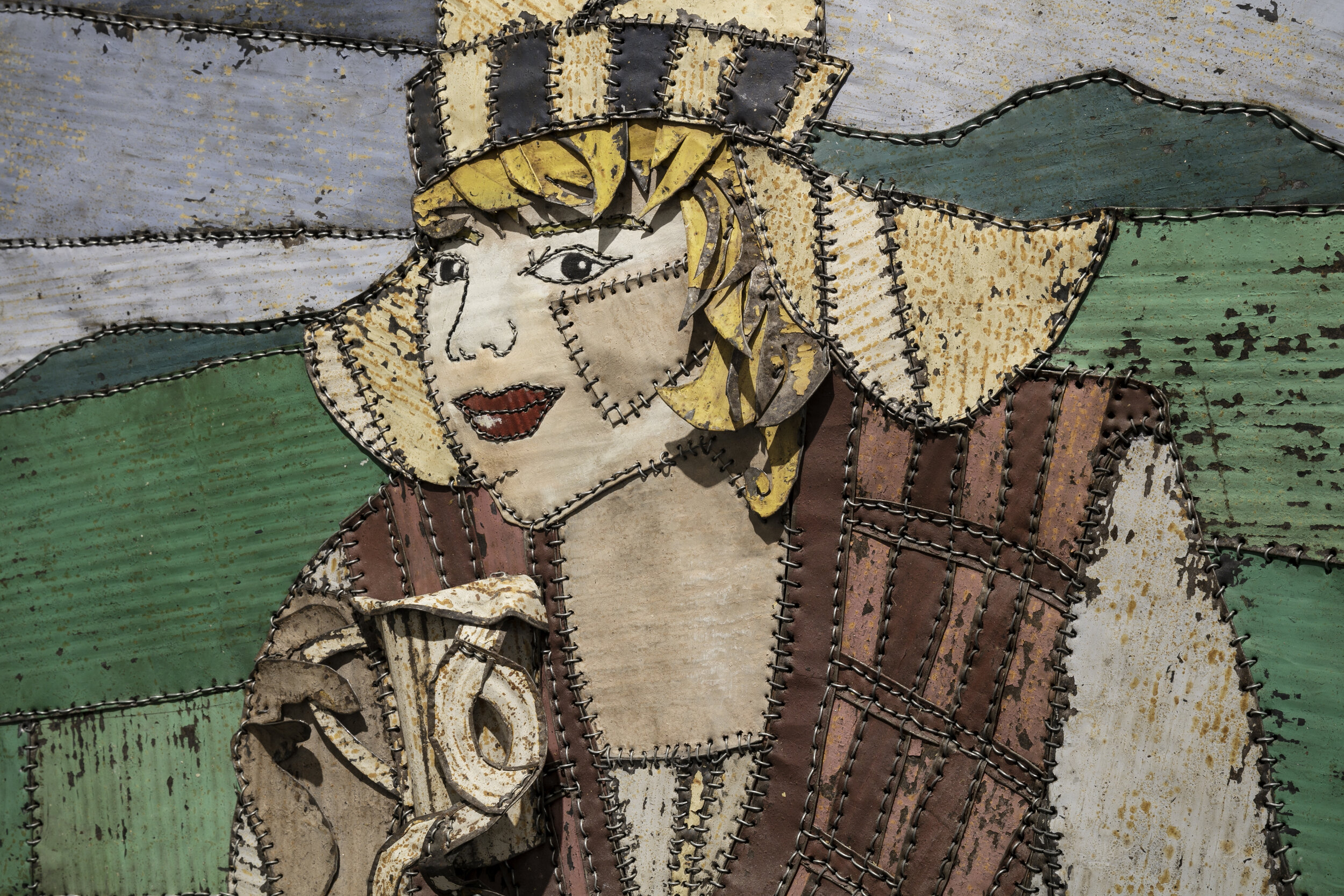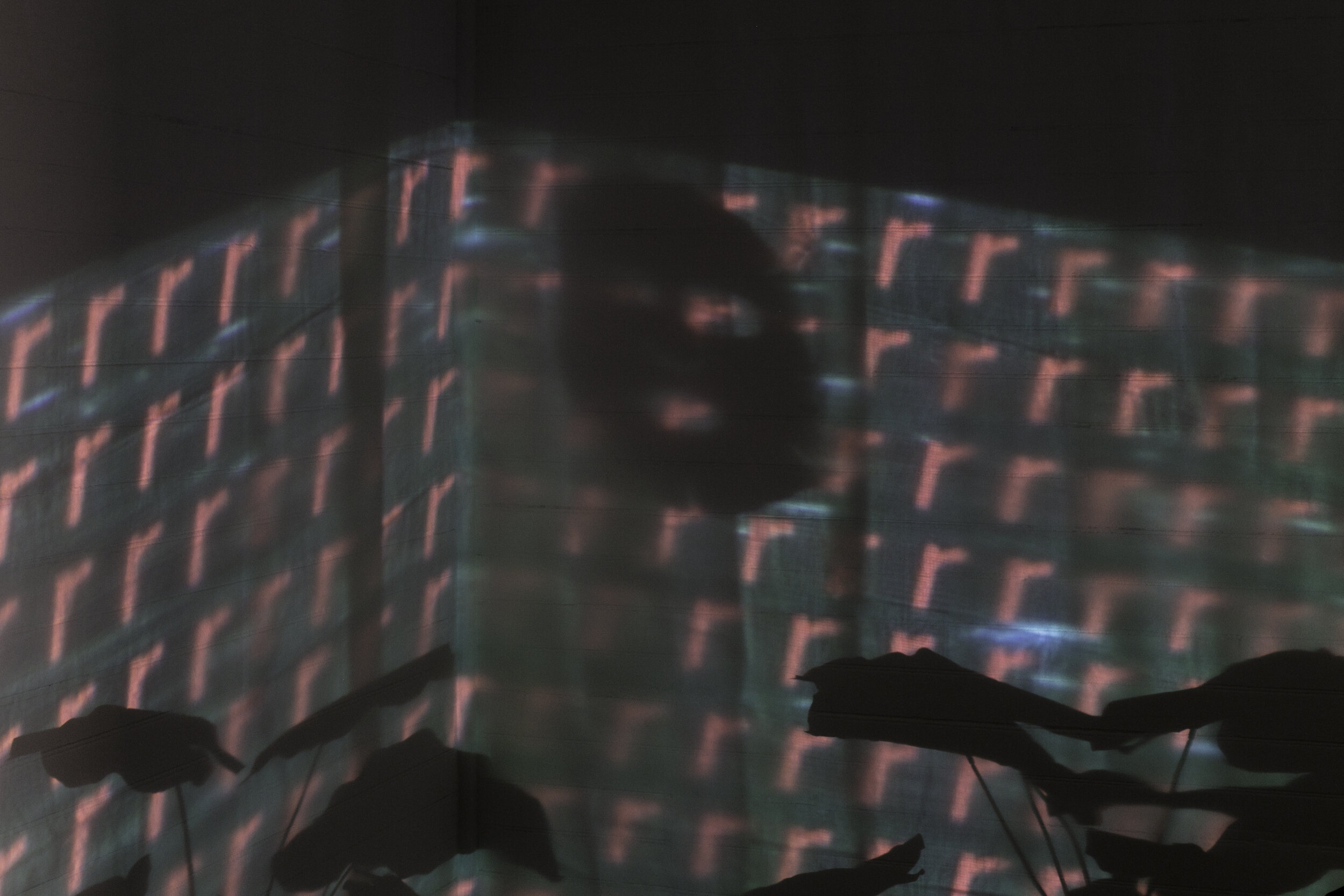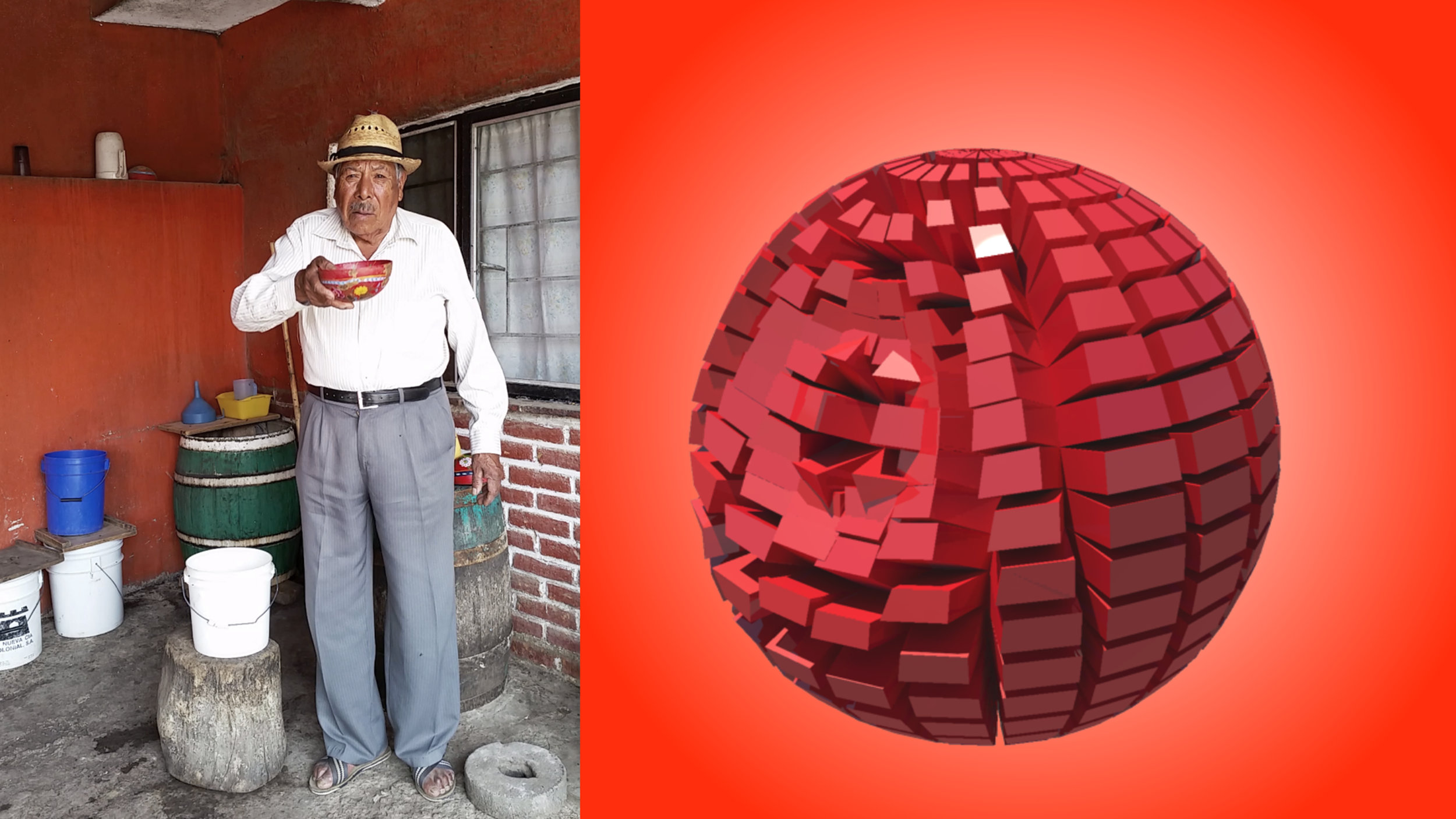July 14- August 5, 2018
Opening reception Saturday July 14th, 2018
Room 1:
Convoluted (detail), Paper, thread, wire, polyurethane, 24” x 38” x 12”, 2018
Cynthia Scott
Convoluted
Unpack any polarizing issue and you will find convolution. Underneath the red/blue - black/white - male/female - bull/bear argument is often a tangle of contradictory and simultaneously congruent feelings.
Is climate change caused by manmade global warming or planetary geologic evolution or (perhaps) both? Is that flirtatious interest or power-based predation? How do I teach my child not to hate or fear when he’s been hurt by someone who doesn’t look like him? Is America a benevolent, generous country or an economically colonizing evil empire?
The works in Convoluted encourage a deeper dig, an uncomfortable conversation with that nasty uncle/coworker/neighbor and an attempt to unravel the tangle that will help us find the point of convergence that lies between the poles.
Note:
I wrote the above before the resignation of Justice Anthony Kennedy. The accelerating slide toward oligarthy has me rethinking everything.
- Cynthia Scott
Cynthia Scott followed a BFA in Sculpture from RISD with stints as an actress (Aliens) and singer (Red Flame/Virgin 10 Records) in New York, London and Los Angeles – eventually completing the circle by establishing a home and art studio in New Orleans, receiving her MFA in Studio Art from Tulane University in 2008. Scott is the recipient of several public art commissions, an Artist Fellowship, and numerous grants from Louisiana Division of the Arts, Louisiana Cultural Economy Foundation, the Contemporary Arts Center’s SweetArts Fund, and Transforma Projects. She has exhibited in London, Edinburgh, Mexico City, New York, Los Angeles, Houston, Atlanta, Providence, Baltimore, Cedar Rapids, Minneapolis, Nashville, and cities in Louisiana, Alabama, Texas, South Carolina and California. From 2009 to 2011 she established and coordinated Current:NOLA, a discussion group/think tank of artists and writers engaged in raising the national and international profile of contemporary New Orleans visual art through dialogue, promotion, and critical writing. She was a founding member of Staple Goods collective and is a current member of The Front.
Room 2:
Anita Cooke, Marianne Desmarais, Abdi Farah, Maria Levitsky, and Sadie Sheldon
Piecework
Curator’s Statement
Few people are unfamiliar with the patchwork quilt – that handed-down, often mended and re-mended demonstration of thrift and “making do” in an effort to salvage scraps of former goods and transform them into a second useful life. Many of these early graphic examples of Reduce-Reuse-Recycle have graduated to museum status – or at least family heirlooms.
The art quilt movement of the 70s advanced the status of this purported female craft to academia and beyond. While still not achieving the realm of Gagosian, quilts became an accepted art medium in their own right, especially lending their adaptability and accessibility to artists with a sociopolitical practice. The AIDS Memorial Quilt of 1987 contained 1,920 panels stitched by artists nationwide. Today it has grown to 48,000 panels and is “the largest community art project in the world.” [International Quilt Study Center and Museum].
None of the artists in Piecework would consider themselves to be quilters. Instead, their experimentation with the slicing of a multiplicity of materials into fragments and reassembling them into unexpected compositions and narratives is the aesthetic and conceptual link. The parallels to our multi-tasking/channel surfing/cross platform integrating/ball juggling daily life cannot be ignored.
Cynthia Scott
Anita Cooke, Blue Vertical, Acrylic on canvas, thread. 43" x 56"
Anita Cooke https://anitacooke.com/
I grew up in the Midwest where ‘being productive’ ruled. There were big fields with their rows and rows of cornfields, stacks of hay bales, the International Harvester factory that produced acres of bright red, yellow and green tractors lined up in rows outside, and then there was my father, who was a materials estimator for a construction company and dealt with building materials in large numbers: so many doors, windows, I-beams, so many feet of concrete, how many bricks, etc. that I would see stacked in massive piles when he’d take me to visit a building site.
In my work I compile parts, layering and stacking, making rows and piles, piecing it all together. Aesthetically I’ve not generally been drawn to the clean, spiffy sparkly-ness of finished products. I’ve always wanted to look at the inside or the underneath because that’s where all the drama is with its evidence of the human touch of the maker; all the cut, loose threads, the ripped-out do-over’s, the trowel marks in mortar, the bulldozed earth all speak to me of a process reflecting the messiness and struggles inherent in life. This ‘quilt’ is also a formal study in composition, perhaps a fragment of an aerial view.
Marianne Desmarais,Tiling Field Shift (detail), Basswood on linen, 7’ x 4,’ 2015
Marianne Desmarais www.marianne-desmarais.com/
Tiling Field Shift series:
Expanding the idea of shift specifically, gravity and tension register in composite textiles of wood and linen. Where one material is rigid the other is soft, where one resists the other collapses. Each piece reveals that balance is a state between equal and opposing forces. Hinge points are both determined and confounded by interconnecting shapes. This duality of movement and rigidity locates temporal stasis in each piece through pinned connections. The works move off the surface of the gallery walls to approach the viewer physically, to push and pull space.
Tiling Studies:
In drawings of graphite and gouache, five basic shapes combine serially to create open patterns and emergent forms. The direct mechanism of geometry explores perceptual dimensionality. Color is deployed to replicate the optical tweaks that occur in the assemblage of pattern. The wet gouache subtly bends the paper while the shapes torque the page. Forms dissolve and converge in slippery patterns of depth and transparency.
Marianne Desmarais works with form and material to amplify the relationships between constructive parts. Techniques from architectural practice are applied in drawings and sculptures that attempt to alter space through the manipulation of geometry, optics, and surface. Her work has been featured in Ceramics Monthly and collaborative work has appeared in Azure and FiberArts magazines. Recent solo shows include POLYMORPHS at Cole Pratt Gallery, samples + patches, an exhibition at the Contemporary Arts Center, and Transpositions at Staple Goods Gallery. Marianne has participated in group shows in New Orleans at the Antenna Gallery, the CAC, NOMA, and the Ogden Museum. Her collaborative work has been displayed in several cities in the United States as well as in Canada and China. Marianne lives and works in New Orleans. She holds Masters of Architecture degrees from Tulane University and Cranbrook Academy of Art and has studied abroad at the Edinburgh College of Art. In addition to studio art, she maintains an architectural practice and is a Professor of Practice at the Tulane School of Architecture.
Abdi Farah, I Want My Spot Back, Conté on canvas, acrylic and house paint on patent leather and recycled billboard vinyl, used clothes and assorted fabrics. 78” x 74,” 2018
Abdi Farah www.abdifarah.com/
My art reinterprets and reconfigures sports memorabilia and apparel. I want standing in front of my work to feel like standing in the presence of a physically intimidating athlete. One banner, One Thousand Year Reign , is over six feet wide and six and a half feet tall; like Leonardo’s Vitruvian Man standing on his tiptoes, or an NFL Draft prospect having his wingspan measured by team scouts. In each work I am looking for shapes that project power: the perfect circle of a Spartan Shield; the triangles of the Egyptian
pyramids; the columns of a grand state building; the consistent widths of the stripes in the American flag. Through my process – deconstructing, poking holes, re-creating concrete forms out of flaccid fabrics – I look to render these structures of power weakened and compromised.
Baltimore native Abdi Farah began his art education at the George Washington Carver Center in Towson, Maryland. Farah received his bachelor’s degree from the University of Pennsylvania in 2009 and his MFA from Tulane University in 2018. Farah has exhibited work across the country and internationally at institutions including, the Baltimore Museum of Art, the Corcoran Gallery of Art, the Margulies Collection, The Institute for American Universities in Aix en Provence, France, the Ogden Museum of Southern Art, and the Acadiana Center for the Arts in Lafayette, LA, to name a few; and highlighted by a solo exhibition at the Brooklyn Museum. Abdi represented Maryland as a 2005 Presidential Scholar in the Arts, received the Ellen Battell Stoeckel Fellowship through the Yale Norfolk School of Music and Art in 2008, and in 2017 attended the Skowhegan School of Painting and Sculpture.
Maria Levitsky, Mountain, Silver gelatin prints, tape. 30” x 30” (approx.), 2017
Maria Levitsky https://www.marialevitsky.com/
l would like to upturn the way we look, both at photography and at the architectural environment. Observing, recording and re-interpreting, then intercepting the stream of visual information coming from the world. I sift through it, take it apart, and re-assemble it into a fragmented, reconfigured version of the original. In the process of dissecting the image and the subject matter, it becomes a forensic search for an ontology of the photographic image. This process has resulted in a stirring up and re-imagining the logic of the photographic vision.
Everything begins with the raw material of a silver gelatin print made in the darkroom. The current series of collages uses the detritus of previous failed projects, re-assembling fragments of photographic prints into two sorts of visual objects- image-based, where there are recognizable scenes remaining within the chaotic fragmentary universes, and tone-based, where the fragments are so small that the object seems to made up of thousands of shards of paper. Surreal dreamscapes and starburst explosions made from reclaimed rejected detritus of silver and light.
Maria Levitsky is a photographic artist whose work encompasses architecture, landscape, structures of image-making, and the history of photography. Her photography is in an experimental vein that explores the way in which meaning is conveyed in the image and examines our relationship to the built environment. She uses traditional film techniques to create her photographs, along with some unorthodox treatments of the photographic object. Her work has been exhibited in New York City, Boston, San Francisco, Houston, Memphis, New Orleans and in Europe. Maria is a recipient of fellowships and residencies in the US and abroad. She received an MFA from the University of New Orleans in 2012 and is based in New Orleans since 2010.
Sadie Sheldon, Sweetened Condensed Milk (detail), Recycled food cans, latex paint, galvanized wire. 39” x 29” x 4,” 2012
Sadie Sheldon https://www.sadiesheldon.com/
Sweetened Condensed Milk is part of a series of works that examines what it means to be present. In each work the subject's attention is otherwise occupied, resulting in an unforeseen consequence within the frame. The body of work playfully highlights the events, actions and messes that occur when we're distracted and examines our complacency in the things we leave behind.
Originally from Cincinnati, Sadie Sheldon received a B.A. from Kalamazoo College and an M.F.A. from Tulane University. She has lived and worked in New Orleans for the past eight years and has been a member of the Aquarium Gallery and Staple Goods. Her work is made entirely from recycled materials, like food cans, and explores the possibilities in the discarded objects that fill our public spaces.
Rooms 3 & 4:
Fertile Ground: Fourth annual open call film festival
Still from Ambassadors by Anna Mortimer
Work by James Bassett, Muffin Bernstein, Ruben Castillo, Federico Cuatlacuatl, Sarah Fox, Jezabeth Roca Gonzalez, Margaret Hull, Adam Mathieu, Anna Mortimer, Libbi Ponce, Margaret Rorison, Dan Rule, and Katie Spragg
Juried by Kevin Baer, Vanessa Centeno, Nurhan Gokturk, Robyn LeRoy-Evans, Cristina Molina, and Ryn Wilson
The Front's fourth annual open call film festival revolves around the theme "Cultivation" and includes both short videos and video installations. When our environment is toxic, what do we do to amend our conditions and improve our circumstances? The idiom, “Growth takes work,” can be applied to many areas of our lives and our societies. These films approach this idea, whether it be through growing a garden, fostering relationships, engaging in our communities, taking political action, or more abstract interpretations.
Still from Coapan sin Tiempo by Federico Cuatlacuatl
Still from Tree of Life with Bees by Muffin Bernstein
Installation view of rrrrrrrr by Libbi Ponce
Sarah Fox
She's Alright
Cut and stitched together from books, magazines, and the internet, my creatures are created from our world but do not belong here. They are the “others”, the outsiders that don’t fit within the clear boundaries of society. They have their own history with their bodies and their own ideas of beauty. They are an investigation and acceptance of difference.
Sarah Fox’s multi-media narratives and characters are created from embodied female experience. Stories of life, loss, love and sex are told through corporeal hybrid creatures. They resulting collages, drawings, sculptures and animations suggest a childlike fairytale but with an undercurrent of dark sexual symbolism. Her work has been shown throughout Texas, as well as in the Kinsey Institute (Bloomington, Indiana), Field Projects Gallery (New York, New York), Espacio Dörffi (Lanzarote, Canary Islands), Bedsetter Art Fair (Vienna, Austria), Atelierhaus Hilmsen (Hilmsen, Germany) and Casa Lu (Mexico City, Mexico). She lives and works in San Antonio, Texas where she is the co-director of the innovative community art space Clamp Light Studios and Gallery.
James Bassett
Three is a Forest
we Three we see <> see the forest
for the trees foresee >< not hearing where
<> were not but for when >< we will not be
/\ always already outnumbers us that we /\
- this hour's apt our wills -
- will to spire into dust -
- when wills we leave -
- off-put -
-plast claspt
\/ put out of place our lesser being lest \/
<>us best blest we for no more or less than not having seen><
Until recently, Jimmy Bassett lived, more or less, in Tuscaloosa, teaching American literature at the University of Alabama. At this moment, he lives, more or less, in New Orleans, while completing a PhD from the University of Chicago. He dissertation examines allegory, occasional poetics, and millennial constructions of race during the Civil War and Reconstruction. He also records sounds under the moniker of Sermon Popgun's Smearmory for Doe-Eyed Tatterdemalions.
Muffin Bernstein
Tree of Life with Bees
Pollination is a series utilizing living butterflies and bees with sacred geometric patterns. Sacred geometry is believed to be the source of all life and when one meditates with it you can reach another dimension. By utilizing living butterflies and bees I am hoping to draw attention to these insects that play such a valuable role in our lives. I photograph the living insects and then utilizing photoshop I create a sacred geometric collage with a sky blue background. All my pieces are printed on metal as die cut circles. Utilizing repetition and nature I choose to create a new meditation with each piece in Pollination.
Muffin Bernstein is a Louisiana artist utilizing our ecosystem as her palate. She has been creating photographic nature collages for over ten years. She utilizes sacred geometry because she believes that all life forms from it. Within her photographic collages she conveys the transformative and healing power of nature as well as themes of rebirth and reawakening. In Pollination Muffin photographs living butterflies and bees. The geometric collages can transport a viewer into another dimension within themselves.
Ruben Castillo
Fluff
My work studies our relationship to intimacy, desire, and how this manifest within the ordinary. I am interested in how and where intimacy occurs and what it means to perform such affections. Vignettes of the ordinary circulate in my imagery. My work becomes a meditation on love and living based on the contradictions, uncertainties, and affects drawn from autobiography and my proximity to queerness.
Ruben Bryan Castillo is a visual artist born in Dallas, TX. He received an M.F.A. in visual art from the University of Kansas and a B.F.A. in printmaking from the Kansas City Art Institute. Castillo’s work addresses themes of intimacy, queerness, place, and the body using a range of media including drawing, printmaking, sculpture, installation, and video. He is currently a 2017-2018 Charlotte Street Foundation Studio Resident and a lecturer and shop technician in the printmaking department at the Kansas City Art Institute.
Federico Cuatlacuatl
Coapan Sin Tiempo (Coapan Without Time)
"Coapan Sin Tiempo" was produced in the community of San Francisco Coapan during the 2016, Rasquache Artist Residency. People in the community were interviewed to talk about their family members in the U.S. More than half of the population of this community has immigrated to the U.S, most of these immigrants haven't gone back home for over twenty years
My practice is invested in immigration concerns through the dual lenses of cultural heritage and pressing realities as a means to rediscover and reinterpret current latinx immigrant diaspora. My artistic research focuses primarily on the critical function of my work as an agency for social, political, and cultural advances. (In)visibility often is used as a scope to bring forth pressing concerns in local immigrant communities as well as build a discourse of cultural identity. The current flux of cultural identity in latinx communities is inquired and driven by semiotics and relationships that immigrants have with time and space. Transculturation processes that latinx immigrant communities are undergoing highlight spacial and temporal displacements on both sides of the U.S-Mexican border.
Federico Cuatlacuatl is a Mexican Indigenous artist born in Cholula, Puebla. He then immigrated to Indiana and received his MFA specializing in Digital Arts at the Bowling Green State University. Federico's work is invested in disseminating topics of Latinx immigration, social art practice, and cultural sustainability. Building from his own experience growing up as an undocumented immigrant and currently holding DACA, Federico’s research is primarily concerned with pressing realities in current social, political, and cultural issues that Latinx undocumented immigrants face in the U.S.
jezabeth roca gonzalez
Una Colección de Himnos sin Sonido (A Collection of Hymns without sound)
"Nothing Special Elements of Being" and "Fabrication of Self" (FOS) are videos part of a in progress Installation, inspired and inform by hurricane Maria and Puerto Rico my homeland. Quotidian Rhythms performed in a contact choreographic form. The videos focus on co-dependency. The realization of human need of others. The notion of relationships within mimicry one body is in movement with the push of another body and nostalgic need for my homeland. The works were made after a few months of dead end, limited contact to my family in Puerto Rico after hurricane Maria and keep changing with the traumatic developments post hurricane life.
My work focuses on the impact on Latinx identity within American culture– and the discord created by the two. I am interested in migration patterns between Americans and Latinx and how its flux contributes to broader cultural ramification. I want to study physical and psychological transitions that are being developed by our forms of cultural preservation. I explore these themes with the use of playful gestures, bodies, sound and collaborative performances that display struggle, force and intimacy to uncover the lasting effects of sociological impact created by thought of idealization of cultural relationships. With the use video and photography I attempt to reconstruct and rebuild a forced interruption due to distance.
Margaret Hull
Greening
Through site-specific, gestural performance, video, and sculpture, I examine the relationships between architecture and the female body in public space, where clothing serves as interface between body and landscape.
A radical and tender process, I design, dye fabric, and sew garments that are customized for the bodies of the performers and that fulfill specific tasks. I incorporate repetitive techniques such as embroidery, appliqué, and weaving into garments and props to not only address the materiality of surface application and substrate but to elevate habitual, everyday gesture as performance. Through repetitive gestures that disrupt balance and symmetry in addition to expectations of utility and embellishment, I address the subtleties of nonverbal communication and the impossibility of dressing only for myself.
Often working with a drone and confronting the presence of the lens, I question how we are complicit in surveillance and how we challenge that authority. By exercising freedom of movement – the body as a self-governing agent and as part of a larger, interconnected system – my characters offer alternative pathways to move through the world.
Margaret Hull (b. Richmond, VA) is an artist working in costume, video, and performance. After graduating from the Maryland Institute College of Art in Baltimore, she moved to New Orleans to teach adult literacy, then art at several elementary schools while also maintaining her own studio practice. She has been awarded residencies in Léhon, France, Troy, New York, Joshua Tree, California, and Saugatuck, Michigan. Her work has been exhibited at the New Orleans Museum of Art, the Ogden Museum of Southern Art, and Cranbrook Art Museum among other sites domestic and abroad.
In May 2016, she graduated with an MFA in Fiber from Cranbrook Academy of Art in Bloomfield Hills, Michigan where she received the Mary Walker Phillips Scholarship. She is a member of Cave, an artist-run gallery and studio space in Detroit that is dedicated to showing the work of artists working primarily in installation, video, sound, and performance. She teaches in the Fiber program at College for Creative Studies in addition to Time-based media in the Foundations program at Wayne State University.
Adam Mathieu
Evanescent or: The Dissipation of Memory
In Evanescent or (The Dissipation of Memory) I set out to construct a mound of sand that stands equal to my height. In creating the work I set out to explore themes such as memory, passage of time, and death. The performance originated as I began to concern myself with the idea that the deterioration of memory, like many facets of nature, is unavoidable. I was particularly interested in the notion that by losing memories of those who have died, that their identity too vanishes. The sand sculpture serves as representation of these memories and their fragility.
As I erect the sculpture I repeatedly see it crumble, forcing me to revisit parts I had already built. Further complicating my task are the waves that are constantly eroding the sand as the water pushes and pulls at the sculpture’s base. The division of the structure into handfuls of sand speaks to our nature of pulling memories to construct lives. Eventually though the sculpture as a whole will wither away and become indistinguishable from the sand surrounding it. This unavoidable fate mirrors how we too must succumb to elements of time and nature.
Adam Mathieu is an artist based in Tampa, FL. He received his Bachelor of Fine Arts from the University of South Florida in 2016. Adam's work tends to focus on themes of futility, failure, and the human fragility.
Anna Mortimer
ambassadors
Quary
My short absurd films reveal peculiar characters combatting and destabilising the environments they find themselves framed within. Collaged from hand-made sculptural props, they roll, hide, thrash, morph and upend in a darkly comic queering of the status quo. Incongruous audio, fragmented body parts and uprooted nature further reinforce the awkward, the uncanny and the bizarre. As humanity is gathered, stored, processed and regurgitated these dynamic dramas draw on personal narratives and language. Scenarios repeated over and over deftly reveal the everyday challenges faced by the individual in relation to the collective.
Anna Mortimer was born in London 1957. She has a degree in English Literature, worked as a qualified Nurse, has four grown up children and has practised as an artist for 30 years.
Libbi Ponce
rrrrrrrr
'rrrrrrrr' is a manifestation of the obsessive approach I take to language. Specifically, in my attempt to perfect rolling my r's, in an effort to take confidence in my Latin identity. Inability to roll my tongue led to embarrassment in front of other spanish speakers. The idea of betterment is embodied within the mother-of-pearl face mask adhered to the clear vinyl tablecloth at the installation's entrance. A plastic plant is placed within the corridor which is indicative of the 'imposter syndrome' that I feel as an Ecuadorian-American living in the Latin Diaspora. The video acts as a moving wallpaper and carpet, furthering the complication of home with identity.
Libbi Ponce is a Tampa native born to Ecuadorian immigrants. She makes videos, installations, and performances as a re-processing of memory, assimilation tactics, and media consumption. Ponce has shown her work at the Broad Studio in the PAFA Museum, the Tampa Museum of Art, the Front NOLA, Nous Tous LA, Leimin Space, the Scarfone/ Hartley Gallery, Tempus Projects, Cunsthaus, Portspace, West Parallelogram, the Centre Gallery, and the Gasparilla Festival of the Arts.
She has been published in Mieux Magazine, the Temporary Art Review, the Tampa Bay Times, 83 degrees media, and the USF College of the Arts Newsletter. Ponce was a 2017 Dina Wind Fellow at the inaugural session of the Currents Summer Residency at the Pennsylvania Academy of Fine Art and received a scholarship to attend the Ox-Bow School of Art & Artist’s Residency. She will be exhibiting a collaboration with Offsite Project in July.
Margaret Rorison
One Document for Hope
I primarily work with sound, texture and abstract imagery. I explore nonlinear narratives surrounding nostalgia, memory and the infrastructural sublime within the urban landscape. My work is expressionistic, exploring personal biographical and autobiographical narratives. I am constantly exploring new ways to address the sensation of contractions in modern society, the layers of history and the visceral nature of memory embedded in landscape. I explore this through 16mm films, digital and 35mm photographs, drawings, projections and sound recordings. I often hand process my 16mm films, embracing chance and improvisation. Depending on the subject matter and intended viewing experience, the presentation varies between gallery space, venue and cinema.
Margaret Rorison is filmmaker and curator from Baltimore, MD. Her works often develop from explorations through rural and urban landscapes, combining language, sound and imagery to create installations, films and live 16mm projections. Her recent films explore the visceral nature of memory and its dialogue between space and experience. She is interested in the potentials of storytelling through the use of 16mm projection and sound, often collaborating with sound artists, exploring ways in which the image and machine can converse. Her work has been exhibited at Anthology Film Archives, Ann Arbor Film Festival, Edinburgh International Film Festival, Images Festival, Miami PULSE Art Fair, Mono No Aware VI & VII, Microscope Gallery, The Moscow Museum of Modern Art and The National Gallery of Art in Washington D.C. In 2012, Rorison co-founded the experimental film and workshop series, Sight Unseen and has been an active curator of the series since.
Dan Rule
Waterfall
These video collage installations are fabricated from YouTube videos, online photos, nature desktop wallpapers, animation and some ‘real life’ shooting. They were made without visiting anyplace worth seeing. Using the visual conventions of landscape painters throughout time, the surreal combinations emphasize and subvert our idealized visions of particular landscapes. The Cave, the Waterfall, the Valley, etc. as ideas are made into places both pastoral and unsettling.
Katie Spragg
In the Meadow
Combining clay with a range of processes including animation, illustration and installation, I create work that aims to arouse curiosity. Whether through sharing a story or conjuring a collective memory, my practice highlights the forgotten sources of joy and amusement that surround us.
My current body of work advocates the simple pleasure of being outside in nature; I am interested in the way that humans and plants co-exist – how we attempt to curate nature yet it proceeds to grow and thrive beyond human ordering.
While the fired ceramic pieces capture a moment in time, the animations describe the dynamic, receptive qualities that clay and grass share. They record the durational element of making and the elastic sense of time that is felt when in nature.
In the Meadow explores these qualities of both grass and clay; they're movement, receptiveness and ability to capture a trace or presence.
You are transported into a dreamlike clay meadow where an unseen creature moves through the grass. Have you been here before?
I have hand-modelled each blade of grass to create these scenes, they are then lit and brought to life using stop-frame animation.
The Wilds of 5 Lely Court
Inspired by my childhood experience of the natural world, The Wilds of 5 Lely Court shows us that the magic and wonder of nature is not restricted to our traditional (possibly sublime) interpretations of it. In this short stop-frame animation, an urban concrete landscape is transformed into a flourishing habitat as porcelain weeds push through a crack in the pavement.
Katie Spragg is based in London, UK, she graduated with first class honours from BA 3D Materials Practice at Brighton University in 2010 before completing and an MA Ceramics & Glass at the Royal College of Art in 2016. She has exhibited, held residencies and taught ceramics at institutions both nationally and internationally – including South Korea, Denmark and Germany. Recent achievements include the acquisition of her piece Hedgerow by the Victoria and Albert Museum, shortlisted for the British Ceramics Biennale AWARD show, Her first solo show at Blackwell, the Arts and Crafts House in 2018 as well as two digital works exhibited to coincide with the exhibition of Monet’s Haystacks: Snow Effect at Abbot Hall Gallery, Kendal, her animations featured in the British Crafts Council’s touring film festival Real to Reel, commissioned to run a project for the TATE Exchange programme as a member of the collective Collective Matter, being twice selected for the Charlotte Fraser Award during her time at the RCA.
